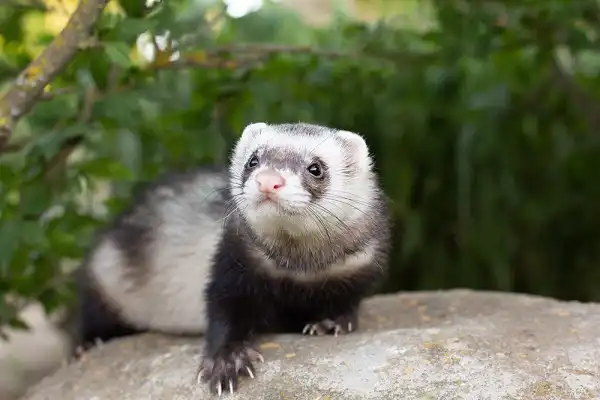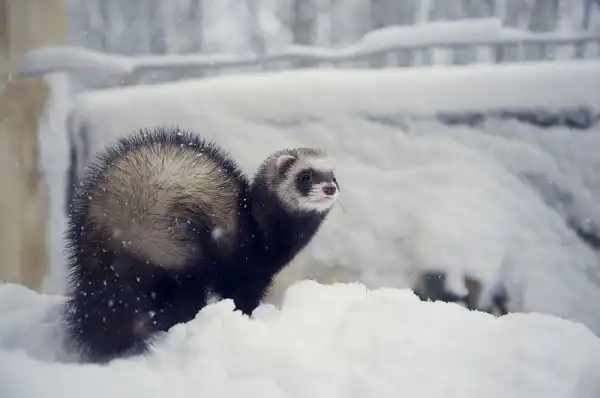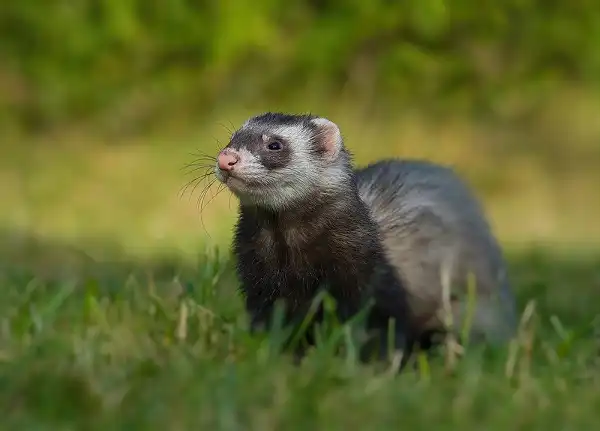Have you ever wanted to own an exotic pet? Consider adding a sable ferret to your family! These lively, adorable creatures feature distinctive black and chocolate brown coats with vibrant white markings. Not only are they amusingly energetic but also wonderfully playful, making them a delight for the whole family. Even better, their gentle nature means that they get along well with kids and dogs alike. Beyond that, owning a sable ferret is actually quite easy – they need surprisingly little space, and grooming requirements are minimal. Read on and explore even more fascinating facts about these small yet mighty animals!

Sable Ferret Description
Sable Ferrets are characterized by their elongated bodies and short legs, which contribute to their unique, slinky movements. Males are generally larger than females. The sable ferret’s coat is primarily dark brown to black, with a lighter undercoat. The fur around their eyes and on their nose is often a rich mask of black, accentuated by a white or cream-colored strip across the forehead. The eyes of a sable ferret are one of its most compelling features. They are bright, and expressive, and come in a range of colors from dark brown to black. Their ears are small and round, lending an additional layer of charm to their overall appearance. The feet of these ferrets are equipped with sharp, non-retractable claws used for digging and play.
Sable Ferret Habitat
Sable Ferrets are highly adaptable creatures, capable of thriving in a variety of environments. However, they are predominantly indoor pets and require a safe and comfortable living space within the home. For a sable ferret, their habitat should be large enough to allow for free movement and play. A multi-level ferret cage is highly recommended, providing them with plenty of space to climb and explore. This also helps in promoting physical activity which is essential for their health. The floors should be solid rather than wired to protect their feet, and the cage should be positioned away from direct sunlight and drafts. Inside the cage, bedding is an essential component of a sable ferret’s habitat. Ferrets enjoy cozy and warm sleeping areas, so providing nesting materials like soft towels, blankets, or ferret-specific bedding can contribute to a comfortable environment. They also love to hide and tunnel, so adding tubes, hammocks, and hideaways in the cage will help in stimulating their natural behaviors. Additionally, ferrets are very clean animals; hence, a litter box in one corner of the cage is very important. Outside the cage, sable ferrets require daily out-of-cage playtime in a ferret-proofed area for physical exercise and mental stimulation. It’s important to remove any small or toxic items they could potentially ingest or any spaces they might squeeze into and get stuck. Toys play a crucial role in a sable ferret’s playtime.
Sable Ferret Diet
Sable Ferrets are obligate carnivores, meaning their diet predominantly consists of meat. Their natural diet in the wild comprises small mammals, but in a domestic setting, their nutritional needs are best met through the feeding of high-quality, meat-based ferret food. Ferret-specific diets, available commercially, typically contain a high proportion of animal protein and fat, along with a small amount of fiber. While some ferret owners opt for cat food, it’s crucial to note that not all cat foods are suitable as they may lack the necessary nutrient concentration. Therefore, if you do choose to feed cat food, it should be high-quality kitten food that is protein-rich. In the quest to enrich a sable ferret’s diet and occasionally offer dietary variety, some ferret owners introduce raw or cooked meat into their pets’ diets.
This could include chicken, turkey, or rabbit meat. However, it’s important to ensure that any meat provided is fresh and free from any seasoning or marinade that could potentially be harmful to the ferret. Raw eggs can also be given as a protein source but should be offered sparingly. While some ferrets enjoy fruits and vegetables, these should only make up a tiny fraction of their diet as their digestive systems are not designed to process high amounts of fiber. Water is an essential part of a sable ferret’s diet. These animals should have access to fresh, clean water at all times. Dehydration can quickly lead to serious health problems in ferrets.

Sable Ferret Size
As mentioned earlier, Sable Ferrets are small creatures, with males typically being larger than females. A full-grown male sable ferret can weigh anywhere between 2 to 3.5 pounds, while females usually weigh between 0.75 to 2.5 pounds. The weight can vary based on factors such as genetics, diet, and overall health. It’s important to keep an eye on your ferret’s weight and consult a vet if you notice any significant weight changes, as this could be a sign of health issues. In terms of length, Sable Ferrets are impressively long for their size, typically measuring between 18 to 24 inches from head to tail. This measurement includes the length of their tail, which can be up to 5 inches long. Their long and slender bodies contribute to their unique, slinky movements, allowing them to navigate through narrow spaces with ease.
Sable Ferret Lifespan
Sable Ferrets have an average lifespan of 5 to 9 years when kept as pets, although some can live beyond 10 years with optimal care and a healthy lifestyle. Like other pets, their longevity is influenced by factors such as diet, exercise, genetics, and the quality of veterinary care they receive. Regular check-ups at the vet can help detect health issues at an early stage and potentially increase the ferret’s lifespan. Healthcare for Sable Ferrets includes vaccinations, dental care, and preventative measures against parasites. A balanced diet of high-quality, meat-based ferret food is crucial for their health and longevity, as is regular physical activity. Obesity can lead to health issues in ferrets, so it’s important to monitor their food intake and ensure they get plenty of exercise. Despite the care and attention that pet owners provide, it’s important to note that ferrets are prone to certain health conditions that can affect their lifespan. These include adrenal disease, insulinoma, and lymphoma. Early detection and treatment of these conditions can significantly improve a ferret’s quality of life and potentially extend its lifespan. Thus, regular visits to the vet, a healthy diet, plenty of exercise, and a safe living environment can help your Sable Ferret live a long, happy, and healthy life.
Sable Ferret Behavior
Sable Ferrets are known for their playful and spirited nature. They are highly sociable animals with a strong inclination towards exploration and play, making them an entertaining companion. Given their natural curiosity, ferrets often indulge in activities like tunneling, burrowing, and hiding objects. They are also fond of interactive toys, which can keep them mentally stimulated. However, their high energy levels demand regular playtime outside of their habitat, failing which, they might resort to destructive behaviors out of boredom. Despite their playful nature, they also have periods of deep sleep, known as “ferret dead sleep”, during which they might not respond to stimuli.
Ferrets are also known to exhibit a unique behavior called the “weasel war dance”, which is a series of frenzied sideway hops, leaps, and bumping into nearby objects. Despite its name, this behavior is not an act of aggression. On the contrary, it’s a sign that the ferret is excited and wants to play. It is common for ferrets to vocalize during this dance, often making a soft clucking noise known as “dooking”. This is a sign of a happy and content ferret. However, loud and persistent hissing or screeching can indicate fear or anger, while a high-pitched squeal might signal pain or distress.

Sable Ferret Speed
Sable ferrets are spry animals, and their speed is one of their defining characteristics, which contributes to their agility and playful nature. They are incredibly quick and can reach speeds up to 2 miles per hour. Although this may not seem swift in comparison to other animals, it is impressive considering their small size and short legs. Their speed, coupled with their nimble bodies, allows them to navigate through tight spaces and play with fluidity and grace. In addition to raw speed, Sable Ferrets also possess great endurance.
They can maintain their quick pace for a considerable amount of time, especially when engaged in play or exploration. This sustained speed is vital for their inquisitive nature, allowing them to investigate their surroundings and engage in their inherent burrowing behaviors. So while they may not be the fastest creatures around, they certainly won’t tire easily, and are often ready for more action after a short rest. Despite their remarkable speed and stamina, it’s important to remember that these are indoor animals and shouldn’t be let loose in an uncontrolled outdoor environment.
Sable Ferret Reproduction
Sable Ferrets, like all ferrets, are seasonal breeders, with their breeding season typically occurring in spring. The females, known as jills, come into heat during this time and remain that way until they mate. It’s important to note that prolonged estrus can lead to health issues in jills, including a potentially life-threatening condition known as aplastic anemia. Therefore, if a female ferret is not intended for breeding, veterinarians often recommend spaying or using hormonal treatments to prevent this condition. The mating process among ferrets is quite unique. The males, or hobs, exhibit aggressive behavior during mating, often dragging the jills by the scruff of their necks. This behavior, while alarming to some, is instinctual and normal. Once mating has occurred, the gestation period for jills is usually around 42 days.
They can give birth to a litter of 1 to 8 kits, with the average being 3 to 4. During this time, it’s crucial to provide the expecting mother with a comfortable, quiet, and stress-free environment. Once the kits are born, they are blind and deaf but grow rapidly. Their eyes and ears open after about 34 days, and they begin to explore their surroundings. The mother ferret weans them off her milk and onto solid food around the age of 6 to 8 weeks. While the mother is responsible for the immediate care of the kits, both parents play a role in teaching them essential skills such as hunting and social behaviors.
Sable Ferret Hunting
Sable Ferrets exhibit exceptional hunting skills, a trait that has been honed through evolution and is deeply ingrained in their behavior. Ferrets, in general, are natural predators, and their slender, elongated bodies are perfectly designed for pursuing prey through narrow burrows and crevices. Their sharp teeth and claws, acute hearing, and superb sense of smell make them efficient hunters, capable of catching and subduing small rodents, insects, and other small creatures. In the wild, sable ferrets predominantly hunt during dusk and dawn, when their prey is most active. Their hunting process is characterized by a keen exploration of their environment, utilizing their sense of smell to locate potential food sources. Once prey is found, they swiftly pounce and immobilize it with a precise bite to the back of the neck, a testament to their predatory nature. However, in captivity, this instinct is often redirected towards play, as they no longer need to hunt for sustenance.

Conclusion
Sable ferrets are undoubtedly fascinating creatures, exhibiting a unique blend of agility, endurance, and playful charm. Their intrinsic hunting instincts, coupled with their swift and spry movement, make them intriguing to watch and interact with. Their complex breeding behaviors and the growth and development of their kits further underscore the depth and richness of their species. However, it’s crucial to remember that while they may exhibit behaviors reminiscent of their wild counterparts, they are primarily domestic creatures requiring careful and considerate care. Their health, safety, and behavioral needs must be met to ensure they live fulfilling, happy lives in our homes. Whether as playful companions or curious explorers, sable ferrets bring a unique, engaging presence to our lives.
Frequently Asked Question


